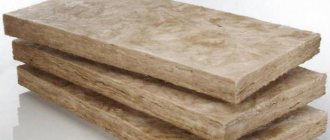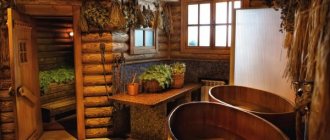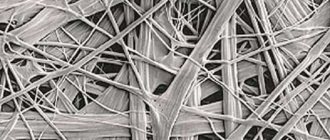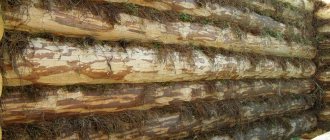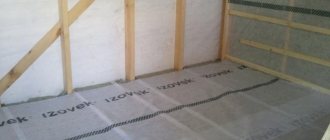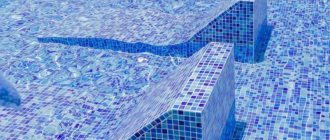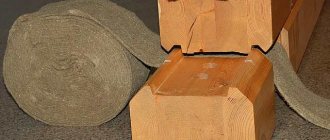There are many different insulation materials. Foil insulating material reflects up to 97% of infrared radiation in the direction of its arrival.
It is made on the basis of expanded polystyrene, foamed polyethylene, mineral and basalt wool. Its effectiveness will depend on proper installation.
In this article, we will look at which side to lay insulation with foil on the floor, the types and characteristics of materials, and the rules for their installation.
Advantages of insulation with foil
Foil-type insulation has many advantages that many other materials lack. It is for these positive properties that foil thermal insulation is so loved by consumers:
- Effective reflection of thermal energy. Foil is an excellent reflector that repels about 90 percent of heat, keeping the heat out and keeping the room cozy and warm. It is noteworthy that this property determines the fact that special suits for fire and rescue services workers are made on the basis of foil heat insulation.
- Waterproofing characteristics. Foil is a material with hydrophobic properties that repels moisture.
- Ease of use. The insulation material with foil has a cellular structure. Thanks to this, it is easy to install and perfectly insulates surfaces from moisture.
- Isolation of surfaces from external influences. The foil type of insulation does not allow dampness or wind flow through it, does not dry out in the summer and does not freeze in the winter.
- Noise suppression. The use of foil insulation allows you to reduce the amount of external noise in the room.
- Environmentally friendly and harmless. Foil does not have any negative effect on the human body. In addition, the material does not harm the environment and does not emit any toxins.
- Long service life. Foil is very durable, as it is resistant to corrosion, rotting and rust.
- High degree of elasticity. Foil material can be easily shaped into one shape or another.
Properties
The materials used in production are most often environmentally friendly, safe for health and the environment.
Related article: How to open an interior door lock without a key: available tools
Advantages:
- light weight;
- durability;
- resistance to loads;
- protection against moisture penetration;
- high rates of heat saving and sound insulation;
- resistance to temperature changes;
- ease of installation;
- high reflective properties.
Such insulation can be used in any premises. In addition to the described qualities, it is capable of reflecting radiation.
Technical characteristics and price issue
It is impossible to name the general characteristics of all foil-type insulation - different materials have different properties. But you can consider the characteristics of the most popular and affordable insulation materials.
Insulator made of foil and polyethylene foam
In most cases, the material is sold in the form of compact rolls. The thickness of the insulation varies from 2 millimeters to 1 centimeter. Foamed polyethylene can be coated on both sides or on one. In addition, self-adhesive material is available on sale, when one of its surfaces is covered with an adhesive layer and a protective film.
The scope of use of polyethylene foil insulation for walls is, as a rule, not limited: they are used for insulation of floors and walls, roofs, ventilation, refrigerators or pipelines. Also quite often, this type of heat insulator is used for installing heated floors, for insulating baths, and as a finishing coating for linoleum or laminate.
To prevent heat from escaping through wall structures, a layer of insulation based on polyethylene and foil is secured behind the heating radiator so that there is about two centimeters of free space between the insulation and it.
Foil-coated polyethylene is often used in shoe production - good shoe insoles are made from this material.
In building materials stores you often find such names of materials as Ecofol, Izolon and Penofol. The price of one roll is directly dependent on the thickness of the material. For example, a roll of thermal insulation with foil 2 millimeters thick will cost about 1,700 rubles. With a thickness of 1 centimeter, the cost will be about 3,500 rubles.
Mineral wool with foil
In this type of heat insulator, only one side is often covered with foil. It is sold in two different formats: rolls and slabs. The thickness of the thermal insulation layer is from 4 to 10 centimeters. It is made on the basis of basalt wool or fiberglass.
The use of foil mineral wool is limited, since the material is harmful to human health, it causes lung diseases and releases phenol into the surrounding space. It is mainly used for external insulation of buildings and non-residential premises. Basalt wool is not subject to combustion; it is installed if resistance to high temperatures is required: on fireplaces, stove pipes, etc.
Properties such as moisture absorption, density and others depend on the brand and type of wool, as well as the characteristics that were included in the material by the manufacturer. The good waterproofing properties of this insulation make it possible to use it in showers, saunas and baths.
The most popular brands are Izover, Parok, Ursa and Rockwool. The cost of the material is approximately 1,300 rubles per 0.25 cubic meters.
Foiled polystyrene foam insulator
This is a high-strength thermoplastic, which is obtained by melting polystyrene granules. Produced only in the form of individual slabs. Such material can be used in places that are subject to significant mechanical stress and moisture - strong polystyrene with foil is not susceptible to rotting and mold or mildew. Therefore, it is often used when installing a warm water floor. The average cost is 90 rubles per slab.
Application
Penefol (closed cell polyethylene foam) is versatile in use. They insulate walls and floors in residential premises.
Foil insulation for pipes and roofing - foil insulation. It is also used in the construction of industrial facilities.
Rolls of mineral wool with an aluminum layer are used in the same way as conventional insulating mats: for insulating walls, floors and other structures. The difference between foil-coated mineral wool and regular wool is the built-in waterproofing; aluminum does not allow moisture to pass into the fibers, preventing the material from getting wet.
The ideal insulation foil for a bathhouse is based on basalt: it has a low heat transfer coefficient, is not afraid of humidity and large temperature changes. As you know, stone wool is a hard material. To roll it into a roll, the basalt is sawed into lamellas, which are laid on an aluminum base. This insulation is used to insulate various social and industrial facilities.
Foiled polystyrene foam is used for floor insulation.
All materials with a layer of aluminum foil have higher technical performance than their traditional form. The cost of foil insulation is an order of magnitude higher than the cost of conventional material; this is the main disadvantage of the “advanced” sample.
Features of using foil insulation
The use of materials with foil for insulation depends on a couple of indicators: the properties of a particular heat insulator and the place where it will be used. In general, with the help of such thermal insulation, floor structures are insulated, the heat transfer of heating radiators is increased, and air ducts and pipelines are finished. Thermal insulation of entrance doors of verandas, loggias, porches and balconies also gives excellent results
When installing foil-type insulation, you need to acquire all the necessary tools for the job:
- Construction stapler.
- Small carnations with large heads.
- Nail puller and hammer.
- Construction tape with foil coating.
- Direct insulation with foil.
The most common mistake many builders make is incorrect installation of the material with the foil surface facing outward. Due to the fact that the foil is a reflector, it is designed to return heat to the room. But if you place the insulating material on the wrong side, you won’t be able to achieve this effect.
When laying foil insulation , it is recommended to enclose it in a wood sheathing.
Slabs, rolls or sheets of material must not be laid overlapping. They must be installed strictly on the same plane, secured with nails or construction staples.
Material with an adhesive surface does not need to be secured with additional fasteners, but to increase service life it is still better to use small nails. In the absence of an adhesive coating, rubber or acrylic adhesive can be used to fix the material on the surface.
After installing and securing all layers of heat insulation, the joints between them must be treated with foil tape. This completes the installation.
When installing a heat insulator on vertical surfaces that have mold, wallpaper or dirt on them, they must first be cleaned, otherwise the fixation will be very unreliable, and the material will simply fall off over time. In addition, it is recommended to treat the surface with antiseptic agents.
Laying methods
Let's consider which side is the correct way to lay the insulation with foil on the floor.
Heat-saving properties depend on how correctly the insulation is installed.
Foil reflects infrared radiation, therefore, the metallized layer must be laid so that it faces the inside of the room.
Insulation of concrete floor
Place the casing with the foil side down
Most often, the rolled material is fixed to the concrete base using a special glue made on the basis of rubber.
Installation sequence:
- We prepare the surface. We level the slab so that there is no large difference in height. We seal all cracks and cracks with cement mortar.
- We spread the material on the floor with the foil layer facing up and cut it to the required length. We move the strip aside and apply glue to the place where it is laid. Let it sit for a few minutes according to the instructions for the glue. We lay and press the material well. We place the strips close to each other.
- We secure the joints with foil tape, which is sold in hardware stores.
For additional insulation of cold floors, wooden logs can be laid on top, the space between which is filled with slab insulation. Floorboards or sheet material (OSB, fiberboard, chipboard) are placed on top of it. For an interesting comparison of foil materials, watch this video:
https://youtube.com/watch?v=RgKvM3-JFRU
Wood floor insulation
It is most convenient to lay the material on an adhesive layer
It is most convenient to lay foil insulation on a wooden floor, which has a bottom self-adhesive layer.
If you bought material without an adhesive base, then you need to fix it with staples using a construction stapler or with double-sided tape.
Laying sequence:
- We remove the baseboards, remove debris and dust using a vacuum cleaner.
- If the boards have uneven surfaces, we sand them with a special machine and, if necessary, sand them (remove the top layer of the board).
- We seal all existing cracks with wood putty.
- We prime with an antiseptic composition.
- We measure the room, cut the roll, and lay it up with foil. It can be easily cut to size using sharp sewing scissors.
- Lay out the strips end to end. We wait a day for the material to settle and straighten out. If the heat insulator has a self-adhesive base, gradually remove the protective film and press it tightly to the surface. We lay the next strip end-to-end.
- We fix the joints of the strips with foil tape.
Foil insulation for heated floors
When laying insulation under heated floors, lay the material with the foil facing up so that it reflects heat into the room
The base for heated floors must be flat without differences in height or defects. All errors must be eliminated.
Stages of laying thermal insulation with a layer of foil:
- We lay out the foil material in strips end to end, and glue the joints with special tape.
- We install a system of electric or water heated floors on top.
- We lay hydro- and vapor barrier material. It will prevent concrete from leaking onto the floor heating elements.
- We fill the screed with a thickness of 30-50 mm, depending on the type of heating elements and the functional purpose of the room.
Insulation under floating screed
Having bought a two-layer material, you don’t have to bother with the question of which side to lay the insulation on
It is characterized by the fact that the slab is not rigidly fastened to the concrete screed; thermal insulation is laid between them.
Installation sequence:
- We prepare the base and eliminate all defects.
- We plaster the lower part of the walls.
- We stick damper tape around the perimeter of the walls; its height should be equal to the thickness of the floor: from the slab to the floor covering.
- We prime the base in two layers. Apply the next layer after the previous one has dried.
- We lay thermal insulating foil boards with the foil facing up. We use a metallized coating that is resistant to cement mortar. We lay the slabs strictly in a horizontal plane, close to each other. Uneven laying of insulation boards contributes to the formation of cracks in the concrete solution.
- We glue the joints of the plates with tape.
- We pour the concrete screed.
Lightweight and durable insulation with a layer of foil is becoming increasingly popular among consumers and professional builders due to its high heat retention and ease of installation. For more information about isolation, watch this video:
We looked at how to properly lay foil material for high-quality floor insulation. Thermal insulating material is always laid with foil on the outside; if you lay it the other way around, it will not retain heat fully.
How to properly lay polystyrene foam with foil
Expanded polystyrene mats for floor insulation and subsequent installation of a low-temperature “warm floor” system.
It is necessary to consider which side to lay the insulation with foam foil in the narrow direction of installation of low-temperature heating systems, that is, heated floors. Now you can find on sale special foam mats (sheets), which are covered with foil on one side. In addition, markings are applied to the foil for laying polymer pipes or electrical cables. As you know, heat sources when installing heated floors must be at a certain distance from each other for the system to work correctly.
In this case, the most important role is played by insulation with foil; how to fix it correctly is a key point. The essence of reflective insulation is to reflect infrared rays, that is, heat. Like a mirror, it reflects up to 97% of all IR radiation. Naturally, the reflected rays must return back into the room, so the logical conclusion on how to lay foil insulation suggests itself. Of course, with the reflective surface inward.
Methodology for laying insulation with foil for heated floors:
- the subfloor is leveled;
- foam boards with foil are glued with construction adhesive;
- Cable or pipes are laid according to the markings;
- everything is filled with screed with reinforcing mesh.
Another important point is how to correctly lay insulation with foil: the slabs must fit snugly to the floor. It happens that due to the unevenness of the mats themselves, they lie unevenly on the floor, even if it is perfectly flat. To correct the situation in places where the thermal insulation does not fit tightly, it is simply cut. That is, several smaller ones are made from one sheet, and the operation is carried out locally, after the mats are laid.
Considering the principle by which foil insulation works, figuring out which side to put is as easy as shelling pears. Reflective insulation should reflect IR radiation into the room; accordingly, it is placed with the shiny side in the middle.
Such slabs are used only for floor insulation; they are not used for walls and ceilings, since there are thermal insulation options specifically designed for this. These include:
- mineral wool in mats and rolls with one-sided or double-sided foil;
- foamed polyethylene with foil.
By the way, ordinary foam plastic or its extruded analogue in tandem with penofol perfectly replaces mats for insulating floors and further laying a low-temperature heated floor system. The only inconvenience is the lack of markings.
If you are going to build a private house, then water heating will be the best option for heating it. There are, of course, air, steam and electric heating, but they cannot compete with a liquid coolant circuit.
The two-pipe water heating scheme for a two-story house can be vertical and horizontal. Drawings with explanations here.
Varieties
Roll insulation materials are classified according to the main material:
- Foamed polyethylene with foil that can be attached on one or both sides.
- Folgoizol is created on the basis of bitumen/rubber, mineral fillers and antiseptic.
- Mineral wool rolls with one-sided foil surface.
- Basalt lamella insulation;
- Expanded polystyrene boards with one aluminum surface.
Each of the presented materials is intended for use in certain conditions.
Which side to attach polyethylene foam with foil
When the question arises about how to attach foil insulation to a wall, most often we are talking about penofol. This is insulation that consists of two layers. The first layer is polyethylene foam, and the second layer is foil. In addition, there are products in which the foil is on both sides. The reflective surface can be glossy, like a mirror, or crumpled (embossed). It is believed that the relief allows you to slightly increase the reflection area, but not critically, so there is not much difference.
Unlike mats for floor insulation, regarding penofol, the answer to the question: “Which side should we attach the insulation with foil?” sounds like this: with a base (foamed polyethylene) to a wall or other insulation.
The thing is that this material is used for both internal and external insulation. It turns out that during thermal insulation of the facade, it will not be possible to put penofol with the shiny side inward; it will look outward. What will this give us:
- Such insulation will not reflect heat from the room, since there is no ventilation gap between the foil and polyethylene;
- the insulation will not let summer heat into the house.
Two-layer reflective insulation, where polyethylene foam acts as a damper and reinforcement.
It is precisely because of the absence of any significant shifts towards increasing the thermal insulation qualities of the room that experts do not use penofol for external insulation. How to properly lay foil penofol insulation:
- should be placed from inside the room with the shiny side facing the heat source;
- there must be an air buffer zone (ventilated gap) between the foil and the finish;
- the material is laid end-to-end;
- secured either with nails or staples;
- The joints are glued with aluminum (not ordinary, but aluminum) tape.
These manipulations are performed in order to create a sealed reflective screen, which additionally acts as a vapor barrier, since it does not allow steam or moisture to pass through. Why, when answering the question of how to properly lay insulation with foil, do we focus on the ventilation gap? The fact is that without it the material will not perform its functions. The air space allows the foil to repel IR radiation from structures in front (plasterboard, lining, siding, whatever).
If there is no air gap, then heat will be transferred to the foil not through IR rays, but through direct contact of the materials. Aluminum's thermal conductivity is exceptionally high, so the process of transferring heat outside the room will even speed up in this case. A thin layer of foamed polyethylene does not create a special barrier to heat loss, and its main function is different: it acts as a damper and reinforcement for the foil, everything else is indirect.
This will cause an undesirable side effect – condensation. The foil does not allow steam to pass through, and it settles on it in the form of condensation. If there is a ventilation gap, then micro droplets of moisture simply evaporate. In the absence of a buffer air zone, moisture collects and is absorbed into the finish, causing fungus to appear. This is what can lead to not knowing which side to put insulation with foil on.
Despite the fact that there is plenty of information about heating a house from sip panels, many can still decide on the method of heating a house made from this material. Although there are quite a lot of approaches that have a lot of advantages and benefits.
You can find all the necessary information about convector heating at home with photos and video files on our website by following this link.
Do-it-yourself wall insulation step-by-step technology
Heat loss through the walls of a house can reach 30% of the total heat loss, so one of the main stages of thermal insulation of a building is wall insulation. Mineral wool is often chosen as insulation for walls. Mineral wools are made from molten glass, rocks or slag; resins are used as a binding element. The material has a fibrous structure, and, depending on the purpose, the direction of the fibers may be different.
Wall insulation with mineral wool
Insulating walls from the outside with mineral wool has a number of advantages:
- This is a relatively cheap insulation with low thermal conductivity;
- Mineral insulation has good sound-absorbing characteristics;
- Mineral wool does not support combustion, so it can be used for insulation of flammable structures;
- This material is vapor-permeable and does not create the effect of a thermos; the building “breathes”;
- Mineral wool is easy to install - the insulation is sold in the form of mats or rolls, you can choose the most convenient option;
- Depending on local conditions, you can select the required thickness of insulation;
Mineral wool does not rot and is not susceptible to fungus, microorganisms and rodents.
The disadvantages of mineral wool include the deterioration of its thermal insulation characteristics when wetted, so it must be protected from atmospheric moisture and condensation. In terms of environmental friendliness, mineral insulation, when used under normal conditions, does not pose any danger, since the release of harmful components occurs only when mineral wool is heated to 300 degrees or more.
The choice of insulation thickness is made using thermotechnical calculations, taking into account the thermal conductivity of the wall material, their thickness, as well as the standard thermal resistance of the walls for a particular region. For a simplified calculation, you can use the table.
Recommendations for insulation thickness in different regions of Russia
Technology of wall insulation with mineral wool
- Preparing walls for laying insulation depends on the material from which they are built. Wooden walls must be impregnated with an antiseptic to avoid damage to the log house by microorganisms. Areas damaged by rot, fungus, and mold must be thoroughly cleaned and soaked in appropriate solutions - after installing the insulation, access to them will be impossible. It is enough to free brick and foam concrete walls from peeling plaster and paint. If the walls are wet, they must be thoroughly dried. Window trims and slopes must be dismantled, and fastening and decorative elements that can damage the vapor barrier and insulation layer must be removed from the walls.
- A layer of vapor-permeable membrane is placed under the mineral insulation. The film is positioned so that the vapor-permeable side faces the wall of the house, and the smooth side faces the insulation. A vapor-permeable membrane is necessary to ensure the removal of water vapor from the walls of the house through the insulation. It is allowed to lay mineral insulation on smooth walls without first laying a membrane film.
Laying a vapor-permeable membrane under mineral wool
Horizontal strip under the bottom layer of mineral wool
Mineral wool laying process
Wind insulation is installed on top of the mineral wool layer.
The process of creating a ventilated facade
When insulating the walls from the outside, their thickness increases, so you will have to install new window slopes, window sills, as well as trim and finishing elements. It is better to purchase them immediately when purchasing a ventilated facade.
Insulating walls outside with mineral wool is one of the most popular methods of thermal insulation of buildings. Its popularity is due to the low thermal conductivity of mineral wool, due to which most of the heat remains inside the building, as well as the environmental friendliness of the material and its ability to remove moisture from inside the house. In addition, mineral wool is an excellent sound insulator.
Other materials are also used to insulate walls, for example, polystyrene foam or extruded polystyrene. These methods are used for plaster finishing, since slab insulation is an excellent basis for plaster.
What to glue mineral wool with foil to
Mineral wool with foil is produced in rolls and sheets. It is attached with universal construction adhesive.
Mineral wool with one-sided and double-sided foil is produced in rolls and sheets of different thicknesses. Mineral wool refers to all its varieties: from glass wool to basalt wool. It, like polystyrene foam, is glued to the wall and is additionally reinforced with dowels. What to glue insulation with mineral wool foil to? For work, use a universal plaster-adhesive mixture, which is suitable for both cotton wool and expanded polystyrene.
When choosing what to glue foil insulation with, you need to consider only high-quality mixtures from leading manufacturers:
If the surface on which the insulation is heated is flat, then apply the adhesive in a 3 cm layer with a notched trowel along the entire perimeter of the thermal insulation sheets. If the cotton wool is glued to an uneven surface, then the glue is applied with a thickness of 4 cm in cakes, the diameter of which is at least 10 cm.
In addition, before laying insulation with foil, you need to clean and prime the working surface for better adhesion. Again, we remind you about the ventilation gap and that the reflective foil should face the inside of the room. This material is not used for external insulation, as it is impractical. Mineral wool with foil is suitable for baths, as it is resistant to high temperatures, but it is afraid of moisture, so it must be protected with a vapor barrier. This does not apply to stone wool, since it practically does not absorb moisture.
Price
in the production of foil insulation on the Russian market :
- Jermaflex;
- Izolon;
- Penofol;
- Tepofol;
- Folgoizol;
- Ecofol.
| Firm | Characteristics | Price |
| Jermaflex | 1.2 m x 8 mm | 80 RUR/m² |
| Izolon | Type A, thickness from 2 to 10 mm, length 1 m | 140-260 RUR/m² |
| Penofol | Type A, thickness from 3 to 20 mm, length 36-12 m (the thicker, the shorter the meter) | 53-278 RUR/roll |
| Tepofol | Type A, thickness from 2 to 10 mm, length 2.5 m | 40-1200 RUR/roll |
| Folgoizol | Type A, thickness 10 mm, length 15 m | 1650 RUR/roll |
| Ecofol | Type A, thickness from 2 to 15 mm, length 25-10 m | 780-1030 RUR/roll |
How to lay insulation with foil for pipes
Shells for insulating communications are made of polystyrene foam and mineral wool.
In addition to thermal insulation for floors, horizontal ceilings and walls, there is also insulation with a reflective layer for pipe insulation. These are shells that are made of polystyrene foam or mineral wool. The former are lighter and are not afraid of moisture, while the latter can withstand high temperatures, which is appropriate when insulating chimney pipes. Considering the fact that the material is already produced in the form of a pipe, the question of whether to put the insulation with foil on the outside or inside is not worth it. There is a shell that you put on the pipe and that’s it, you can’t turn it inside out.
At the same time, there is always a choice when purchasing, since they are also produced with one (outer) or two (outer and inner) layers of foil. Such shells are used for:
- laying pipelines by air;
- laying highways underground;
- laying pipelines in unheated rooms;
- insulation of chimneys.
In some cases, they are used to insulate pipes so that the coolant does not lose its temperature even in heated rooms. For example, in industries where the first and last heat exchanger of one circulation ring are installed at a great distance from each other.
Preparing the Quick Step pad
Knowing which side to put the underlay under the Quick Step laminate flooring on, you can avoid many problems in the future. Correct installation is possible if all rules are followed:
- You need to cut the canvas into squares of a certain size. It is important that the elements are easy to work with and that they correspond to the parameters of the room.
- It is advisable to lay polyethylene film on the subfloor, which will improve waterproofing.
- Place the finished squares on the film with the ribbed side down.
- Tape the joints of the squares with construction tape.
To prevent space from forming between the elements during the work, the installation must be done gradually - as the laminate is laid.
Let's sum it up
So, we found out that there are several types of foil insulation:
- polystyrene foam in sheets for flooring;
- mineral wool in sheets and rolls;
- penofol;
- shells for insulating pipes made of foam plastic and mineral wool.
All types of insulation, except shells, with a reflective layer are intended for internal insulation. The foil should be placed in the middle of the room. Such materials are suitable for external insulation, since the concept of reflecting IR radiation is reduced to nothing. Therefore, there is no point in paying for something that will not bring results.
Foam and mineral wool slabs must be glued using a special plaster-adhesive mixture from trusted manufacturers. The latter include the same Knauf or Ceresit. Laying on the walls is carried out from the bottom up, the sheets are additionally secured with dowels. And the most important thing is the presence of a ventilated gap in front of the reflective surface. If it is not there, then instead of reflecting heat you will get even more heat leakage and, in addition, mold on the finish.
Materials used in the construction of roofs and arrangement of premises with non-standard temperature and humidity operating conditions are endowed by manufacturers with special properties. They not only easily resist the attacks of steam-saturated hot air, but also create a “thermos” effect, due to which energy consumption for heating is greatly reduced.
These specific products include foil vapor barrier, the installation of which allows you to solve a lot of important problems in the construction of building structures.
Video description
About the membrane installation technology in the following video:
- The main condition for installation is that the film is fixed without tension , with a sag of approximately 2 cm. The reserve is created due to the ability of the wooden frame to change its dimensions with the change of seasons (with changes in humidity); otherwise there is a risk of the film tearing.
- For horizontal installation, installation is carried out from above (from the ridge). The strips are laid with a reverse overlap (the lower strip overlaps the upper), for additional protection of the insulation; they are connected with tape and secured to the structure with galvanized nails or a stapler.
- If the thermal insulation layer is not dense, the rolled sheet is fixed using slats , which must be antiseptic.
- Particular attention is paid to junction points (attics, windows, hatches, pipes, ventilation ducts); they are isolated especially carefully.
Fixing the film Source pro-uteplenie.ru
The principle of operation of foil vapor barrier
Foil materials used in vapor barrier devices are complex products with a layered structure. Their base is made of polypropylene fabric, lavsan, fiberglass and similar options that are resistant to tearing, as well as chemical and biological aggression.
The use of a durable woven or non-woven polymer base allows you to create a reliable base for the naturally fragile metal foil. At the same time, it was possible to provide easy-to-install flexibility. The composition of the thermoplastics used in the manufacture eliminates the possibility of decay and the spread of fungal colonies.
On the working side, vapor barrier materials of this category are backed with a metallized film. Thanks to the method of applying the foil coating, all the positive qualities of both the polymer base and aluminum foil are preserved, which copes “excellently” with three very significant functions, these are:
- Insulation from steam and precipitation. Foil materials ideally protect the insulation of a roofing pie or wall insulation system from the penetration of steam coming from inside the house being furnished, and from atmospheric water tending to penetrate from the outside.
- Reflection of thermal radiation. The metallized coating serves as a reflector, interrupting the flow of heat waves outside the heated room and redirecting the stopped heat in the opposite direction.
- Wind and UV protection. Vapor barrier films with foil act as a strong barrier against wind, tending to remove heat from the cotton insulation. Installed with the working side facing outwards, they reflect the sun's rays from the attic roof in the summer heat.
Using a vapor barrier with foil allows you to significantly save on heating bills and turn on the air conditioner less often.
Scope and methods of application
The structure and properties of foil vapor barrier materials have significantly expanded the scope of application. These materials are used in insulated roofs, in our latitudes they are most often installed on the inside of the roofing pie, in the south they are mounted above the insulation. In houses with an unfurnished attic, foil protection is installed in combination with waterproofing.
In addition to the traditional purpose of protecting ceilings and residential attic spaces from vapor, they are used as a substrate for all types of floor coverings and underfloor heating systems, as well as in insulated frame wall structures. They are installed in the form of a screen that reflects heat flows from heating devices and heating units.
In order for foil materials to perform a reflex function, it is important to properly arrange the system. A non-ventilated air gap 2–3 cm thick should be formed between the inner lining of the attic, the walls, the ceiling of the steam room and the metalized coating.
When using a flat or mansard roof as a heat-reflecting screen, a standard ventilated gap of 3–4 cm is left between the metalized coating turned outward and the roof. The goal here is not to conserve thermal energy. Everything that is reflected from the foil can be freely released into the atmosphere along with condensate and steam that has penetrated into the thermal insulation.
Why is underlayment installation important?
Before you decide which side to put the underlay under the laminate, you should know what functions it performs. Professionals recommend that you definitely use this type of building material, which will only have a positive effect on the condition of the laminate. If the substrate is absent, the period of high-quality use of the coating will be reduced by almost 2 times.
The substrate performs the following functions:
- Required level of reversible deformation. The material allows you to smooth out unevenness and differences in the floor surface. At the moment of pressing, the substrate is compacted to the required level, and then returns to its original position.
- A high level of sound insulation, which will help relieve your neighbors from loud sounds from your home and reduce the reverse effect.
- Prevents the appearance of mold and mildew, as it has a high degree of waterproofing. Levels the moisture level of the screed, laminate and main floor surface.
- Thermal insulation. The flooring will be warm at any time of the year. If there is a lining, there will be no need for additional floor insulation.
Overview of leading foil options
In order to choose a suitable vapor barrier film for arranging an attic or ceiling, you need to familiarize yourself with the popular and practice-tested product options from different companies.
Energy saving film DELTA®-REFLEX
Delta brand products have proven themselves excellent in the construction of roofs and have earned an impeccable reputation among roofers. The reflective coating of the material located on the working side is created by spraying. A polyester film is applied over the spraying, protecting the aluminum layer from damage and shedding. The reflection coefficient is 50%.
The film of this brand does not lose flexibility at sub-zero temperatures and can be used in a steam protection device both outside and inside the house. Approved for use in all types of wet rooms. Along the edge of the sheets of a similar film, but with the addition of the word PLUS in the marking, there is a self-adhesive tape, which significantly facilitates the work of installers.
Reflective material Izospan FD
More humane in terms of price, but less resistant to the realities of roofing adversities, the material labeled Izospan FD is a two-layer composition of polypropylene fabric with an aluminum coating applied to it.
It is inferior to the previous representative in terms of strength indicators, but is ahead in terms of energy-saving characteristics: the coefficient determining thermal reflection is at least 90%. Attracts with its affordable price and stable availability in the retail chain. The technical data sheet of the film indicates the temperature range from -60º to +80º.
Super strong version ARMOFOL® type A
Foil vapor barrier with the specified logo is made on the basis of fiberglass mesh. The scope of use is no different from the types described above, but the product has a significantly expanded temperature operating range. The material is capable of flawlessly serving at temperatures down to -60º, in which it is 20º ahead of Delta. The limit in the positive segment is + 150º, which is already 70 more confident units.
Along with its competitor, Armofol can be used in new construction and in carrying out restoration work when repairing roofs, basement and basement structures, steam Russian baths, swimming pools, bathrooms, saunas. The thermal reflection coefficient reaches 90 – 97%.
